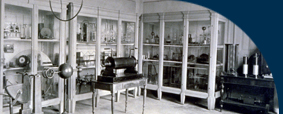
 |
Magneto-electric machine for electrotherapy |
 |
Apparato magneto-elettrico per elettroterapia |
| Subject: electromagnetism/manually operated electroshock therapy generator |
Settore: elettromagnetismo/generatore meccanico di scosse elettroterapiche |
| Number of catalogue: 15 |
Numero di inventario: 15 |
| Unsigned, English, prob. Negretti & Zambra |
Non firmato, prob. inglese, Negretti & Zambra |
| 1895 [document] |
Periodo di costruzione: 1895 [documento] |
| Deal, steel, brass, velvet, silk, leather |
Materiali utilizzati: Abete, acciaio, ottone, velluto, seta, cuoio |
| 200 X 110 X 115 [mm] |
Dimensioni: 200 X 110 X 115 [mm] |
| |
|
This is a portable electrotherapeutic machine, made in England, which was very popular towards the end of the 19th century. By using the magnetic field of a fixed magnet, the device enables one to transform mechanical energy into electrical energy. The principle of its functioning substantially reproduces the original system of the famous "Clarke's magneto-electric machine" (see inventory number 34, Fig. 84) designed in 1836 by Edward Marmaduke Clarke. A paper label, which is on the bottom of the lid that encloses the box, reproduces two explanatory pictures on the use of the device and the following instructions:
Connect two metallic cords or wires with the sockets in the end of the Box, and apply the handles connected with the other ends of the metallic cords or wires to any part of the person through which it is desiderable to pass the current of electricity. Then turn the Crank, regulating the strength of the current by the speed, and by the Knob at the end of the Box; it being desiderable to increase the strength only to that degree most agreable to the patient. It is less unpleasant to the patient if wet sponges are placed in the ends of the Handles, and these applied to the skin, as they prevent the prickling sensation. The sponges should never be put inside of the box while wet, as they rust the machinery. In applying it for the Toothache, Tic-Doloreux, or Neuralgia, the operator takes one Handle and places his fingers or sponge over the part affected, while the patient holds the other Handle. In applying it to the foot, place one of the handles in the water with the foot, and hold the other in the hand, or apply it to any other part of the person. The Bearings and Spring must be oiled occasionally. |
Si tratta di un apparecchio elettromedicale portatile, probabilmente di fattura inglese, molto in voga verso la fine del XIX secolo. Sfruttando il campo magnetico di un magnete fisso, esso permette di trasformare energia meccanica in energia elettrica. Il suo principio di funzionamento riproduce sostanzialmente la disposizione originale della famosa «Clarke's magneto-electric machine» (vedi scheda relativa al numero di inventario 34, fig. 84) ideata nel 1836 dal costruttore di origine irlandese Edward Marmaduke Clarke. Una etichetta di carta, collocata nel fondo interno del coperchio che racchiude la cassetta, riporta due figure esplicative sull'uso dell'apparato e le seguenti istruzioni:
«Connect two metallic cords or wires with the sockets in the ends of the Box, and apply the handles connected with the other ends of the metallic cords or wires to any part of the person through which it is desirable to pass the current of electricity. Then turn the Crank, regulating the strength of the current by the speed, and by the Knob at the end of the Box; it being desirable to increase the strength only to that degree most agreeable to the patient. It is less unpleasant to the patient if wet sponges are placed in the ends of the Handles, and these applied to the skin, as they prevent the prickling sensation. The sponges should never be put inside of the Box while wet, as they rust the machinery. In applying it for the Toothache, Tic-Doloreux, or Neuralgia, the operator takes one Handle and places his fingers or sponge over the part affected, while the patient holds the other Handle. In applying it to the foot, place one of the Handles in the water with the foot, and hold the other in the hand, or apply it to any other part of the person. The Bearings and Spring must be oiled occasionally.» |
| |
|
Description: The magneto-electric machine is enclosed in a fir-wood box closed with two small iron hooks; externally there are a small crank and, at the two extremities, two terminals in which the brass gudgeon-pins of two long copper wires are joined; they have at their extremities brass cylindrical electrodes. Internally the machine consists of: a horizontally placed horseshoe shaped magnet; two small coils with thin wires, which are horizontally fixed and protected by a strip of velvet cloth, and they are able to rotate on one side of the magnet's poles, and a wrought golden wheel, which is provided with a pulley and a transmission belt to transmit the movement to the coils through the manual rotation of the handle. A brass knob on one external side of the box is connected with a small iron bar that short-circuits the magnet's poles to preserve their magnetization over time, enables, if pulled, the opening of the magnetic circuit and use of the device to begin. |
Descrizione: la macchina magneto-elettrica è posta dentro una cassetta d'abete, chiudibile tramite due gancetti di ferro; esternamente sono ben visibili una piccola manovella e sui lati opposti due morsetti nei quali si connettono ad incastro gli spinotti d'ottone di due lunghi fili di rame, portanti alle loro estremità gli elettrodi cilindrici in ottone. Internamente la macchina è composta da: una calamita a ferro di cavallo, piantata orizzontalmente; due piccole bobine accoppiate a filo fine, imperniate orizzontalmente e protette da una striscia di stoffa vellutata, che sono in grado di ruotare su di un lato dei poli della calamita, e una ruota dorata lavorata, munita di puleggia e cinghia di trasmissione per trasmettere il movimento ai rocchetti, tramite la rotazione manuale della manovella. Una manopola d'ottone, posta su un lato esterno della cassetta e connessa con una sbarretta in ferro che cortocircuita i poli del magnete (per preservarne la magnetizzazione nel tempo), permette, se tirata, l'apertura del circuito magnetico e l'inizio dell'uso dell'apparecchio. |
| |
|
Function: By rotating the crank, a periodically induced current is produced in the wires and its intensity is proportional to the rotation speed of the coils; the cylindrical electrodes, after having induced differences of potential, provide the patients with slight yet numerous electroshocks if they were held in the patient's hands or placed in other parts of his body. |
Funzionamento: ruotando la manovella, si genera nei fili una corrente indotta periodica la cui intensità è proporzionale alla velocità di rotazione impressa alle bobine; gli elettrodi a cilindro, così portati a differenze di potenziale indotte, fornivano al paziente, se tenuti per mano o posizionati in altre parti del corpo del malato, dei piccoli ma numerosi elettroshocks. |
| |
|
Bibliography: Dumont [1889], pp. 229-230. |
Bibliografia: Dumont [1889], pp. 229-230. |
|
|

